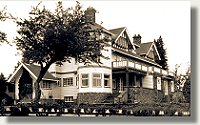 |
Ceperley Mansion - ARCHITECTURAL DESCRIPTION |
 |
Ceperley Mansion - ARCHITECTURAL DESCRIPTION |
 BIBLIOGRAPHY SITE CONTENTS LOCATION MAP MEASURED DRAWINGS TEACHER'S CORNER ARCHITECTURAL INFORMATION DESIGN TEAM HOME |
 When the Ceperley's lived in the mansion from 1910 to 1919, the architecture of the building was quite impressive with its attention to details in the fireplace, doorways, windows, and light fixtures. Originally the home was a three-storey gabled structure, built primarily of stucco and stone, and finished with Tudor timbering (Winifred Denny. The Story of A House: Ceperley Mansion to Burnaby Art Gallery. Chapter III) . The mansion was built to have some characteristics of an English home with the added touch of the West Coast. When the Ceperley's lived in the mansion from 1910 to 1919, the architecture of the building was quite impressive with its attention to details in the fireplace, doorways, windows, and light fixtures. Originally the home was a three-storey gabled structure, built primarily of stucco and stone, and finished with Tudor timbering (Winifred Denny. The Story of A House: Ceperley Mansion to Burnaby Art Gallery. Chapter III) . The mansion was built to have some characteristics of an English home with the added touch of the West Coast.
The Ceperley Mansion was designed to have a stately appearance. At the entrance of the house, a flight of double stairs lead to a raised porch that led to the main doorway of the house. The grand arched doorway, made of solid oak, greeted guests warmly. The main level of the house consisted of a number of rooms, as the living quarters were located only on the second floor. When first entering the building, to the right of the entrance was the main staircase and a hallway that led to the kitchen, butler's pantry, and servants' hall. And to the left was a small study and vestibule. The other rooms on this level included the billiard's room, dining room, and drawing room.
The fireplace was designed in the Edwardian style. It was made entirely of ceramic tile that was imported from Europe. Dutch and Belgium made tiles were used in the dining room and bedrooms(Winifred Denny. The Story of A House: Ceperley Mansion to Burnaby Art Gallery. Chapter III) . From the drawing room, French doors opened onto the cobblestoned verandah outside. Dividing the dining room from the drawing room were heavy wooden sliding doors. Glass cabinets lined the walls of room. These cabinets remained in the mansion until 1967, when it was removed by the Burnaby Art Gallery.
An important feature of the house was the little tower that was off the dining room. This area was specifically made on the request of Mrs. Ceperley to house her tropical and domestic bird collection. The walls of the tower were made of glass and from the tower, there was a door leading to an outside garden. Even though the architect persisted that the tower did not fit the scheme of the house, the tower was still built for Mrs. Ceperley's aviary(Winifred Denny. The Story of A House: Ceperley Mansion to Burnaby Art Gallery. Chapter III)
|
|
 |
 |
 |
 |
| Last updated 31 August 1998. This digital collection was produced under contract to the Canada's Digital Collections Program, Industry Canada. Produced by Canada's Digital Collections Team. Content provided by BC Heritage Trust and Heritage Branch, Province of British Columbia. |